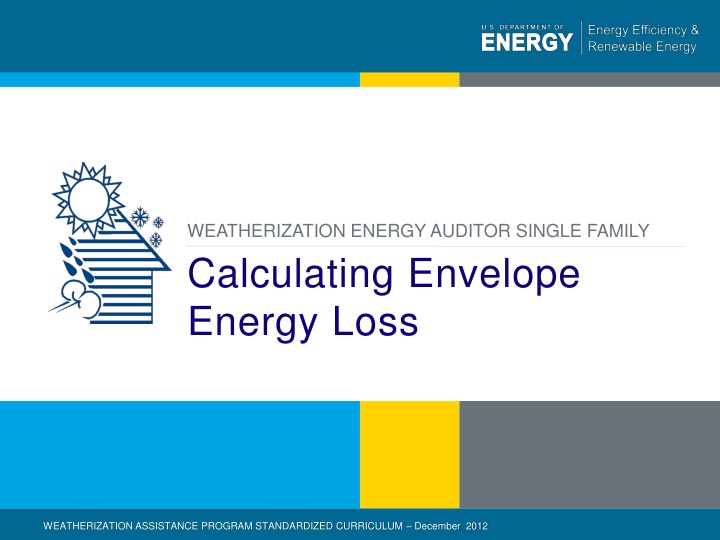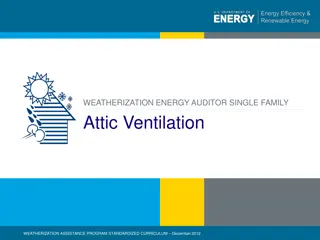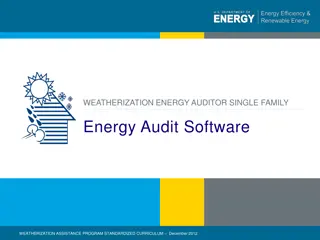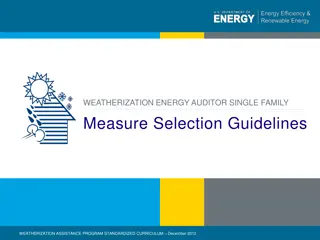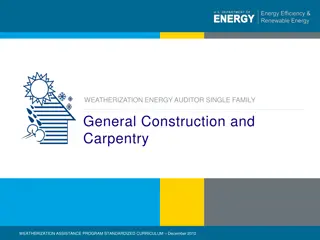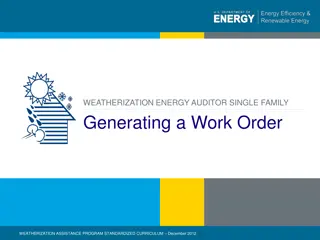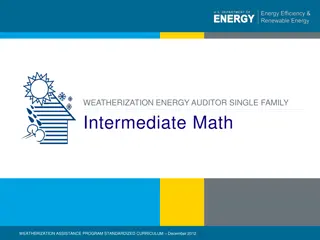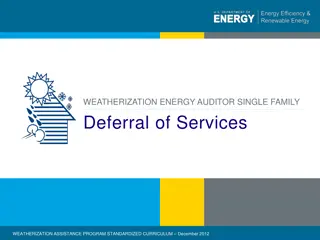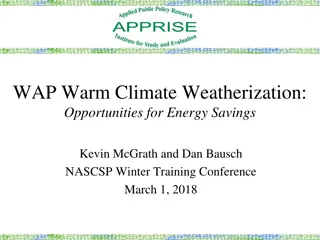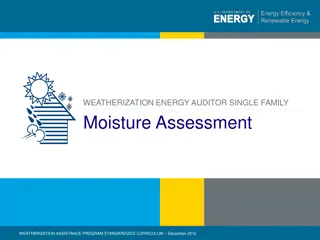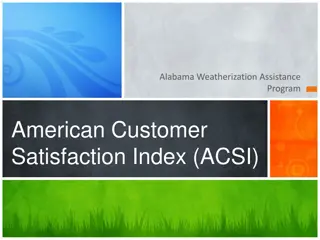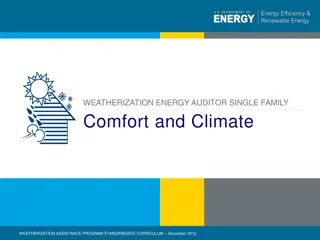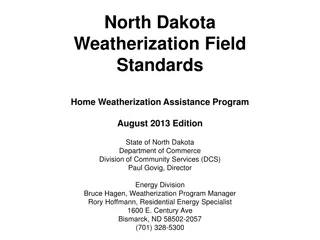Calculating Envelope Energy Loss in Weatherization Energy Auditor Training
Learning objectives in a standardized curriculum for the Weatherization Assistance Program focus on defining energy movement, calculating hourly and annual energy loss, and understanding diminishing returns. The content covers quantifying envelope energy loss, key terms like BTU and R-value, typical R-values for materials, and factors influencing R-value accuracy. It also discusses assembly R-values for building envelopes made up of various materials. Practical examples and insights are provided to enhance understanding of energy efficiency concepts.
Download Presentation

Please find below an Image/Link to download the presentation.
The content on the website is provided AS IS for your information and personal use only. It may not be sold, licensed, or shared on other websites without obtaining consent from the author.If you encounter any issues during the download, it is possible that the publisher has removed the file from their server.
You are allowed to download the files provided on this website for personal or commercial use, subject to the condition that they are used lawfully. All files are the property of their respective owners.
The content on the website is provided AS IS for your information and personal use only. It may not be sold, licensed, or shared on other websites without obtaining consent from the author.
E N D
Presentation Transcript
WEATHERIZATION ENERGY AUDITOR SINGLE FAMILY Calculating Envelope Energy Loss WEATHERIZATION ASSISTANCE PROGRAM STANDARDIZED CURRICULUM December 2012 1 | WEATHERIZATION ASSISTANCE PROGRAM STANDARDIZED CURRICULUM December 2012 eere.energy.gov
Learning Objectives CALCULATING ENVELOPE ENERGY LOSS By attending this session, participants will be able to: Define basic energy movement. State procedures for calculating hourly and annual energy loss. Explain the principle of diminishing returns. 2 | WEATHERIZATION ASSISTANCE PROGRAM STANDARDIZED CURRICULUM December 2012 eere.energy.gov
Quantifying Envelope Energy Loss CALCULATING ENVELOPE ENERGY LOSS Where does the heat go? Photo courtesy of ENERGY STAR; http://www.energystar.gov/index.cfm?c=behind_the_walls.btw_airsealing 3 | WEATHERIZATION ASSISTANCE PROGRAM STANDARDIZED CURRICULUM December 2012 eere.energy.gov
Key Terms CALCULATING ENVELOPE ENERGY LOSS BTU - British thermal unit Heating degree days R-value Guarded hot box Photo courtesy of Life123 Inc. 4 | WEATHERIZATION ASSISTANCE PROGRAM STANDARDIZED CURRICULUM December 2012 eere.energy.gov
Some Typical R-Values* CALCULATING ENVELOPE ENERGY LOSS Fiberglass = 2.4 - 4.4 per in. 3.5 per in. Cellulose = 3.0 - 3.6 per in. 3 per in. Expanded polystyrene 3.6 per in. (Bead board) Extruded polystyrene = 5 per in. (Styrofoam ) Polyisocyanurate board 5.6 7.6 per in. Glass 1 per layer Wood 1 per in. Concrete 1 per 8 in. *See Krigger, PP 103. 5 | WEATHERIZATION ASSISTANCE PROGRAM STANDARDIZED CURRICULUM December 2012 eere.energy.gov
When is an R not an R? CALCULATING ENVELOPE ENERGY LOSS Graphic developed for the U.S. DOE WAP Standardized Curricula Intrusion Wind-washing Both intrusion and wind-washing significantly lower R value. The more porous the insulation, the more the R is reduced. Exposed fiberglass in a well-vented attic will test as much as 50% below its label rating. 6 | WEATHERIZATION ASSISTANCE PROGRAM STANDARDIZED CURRICULUM December 2012 eere.energy.gov
Assembly R-Values CALCULATING ENVELOPE ENERGY LOSS Building envelopes generally consist of layers of materials, each of which resists heat flow. In addition, each layer not in physical contact with another layer has an air film that also resists heat flow. The assembly has in. drywall, 3 in. fiberglass, 2 in. x 4 in. framing, in. plywood, building wrap and clapboard siding.1 The assembly has a total theoretical R of 14. In reality it will test 20% lower; R-10.2 1 Krigger, page 67. 2 Krigger, page 272. 7 | WEATHERIZATION ASSISTANCE PROGRAM STANDARDIZED CURRICULUM December 2012 eere.energy.gov
Quantifying Envelope Losses CALCULATING ENVELOPE ENERGY LOSS Surface Heat Loss: A = Area in sq. ft. T = Difference in temperature in F t = Time in hrs R = Total resistance of assembly to heat flow A x T x t R Air Transported Heat Loss: V x AC/H x 0.0182 BTU/ft , F x T V = Volume of the building. AC/H = Air change per hr 0.0182 BTU/ft , F = Specific heat of air. 8 | WEATHERIZATION ASSISTANCE PROGRAM STANDARDIZED CURRICULUM December 2012 eere.energy.gov
Example: Wall Section Surface Loss CALCULATING ENVELOPE ENERGY LOSS 8 ft. x 12 ft. wall; no windows = 96 sq. ft. 70 F inside - 30 F outside = 40 F T 7,200 HDD R-11 Insulation (Remember: R-11 insulation = R-10 assembly) How many BTU/hr? How many BTU per heating season? 9 | WEATHERIZATION ASSISTANCE PROGRAM STANDARDIZED CURRICULUM December 2012 eere.energy.gov
Wall Section Surface Loss Calculation CALCULATING ENVELOPE ENERGY LOSS BTU/hr? (96 sq. ft. x 40 F x 1 hr)/10 = 384 BTU/hour How many BTU per heating season? (96 sq. ft. x 7,200 HDD x 24 hrs)/10 = 1,658,880 BTU per heating season 10 | WEATHERIZATION ASSISTANCE PROGRAM STANDARDIZED CURRICULUM December 2012 eere.energy.gov
Example: Uninsulated Ranch CALCULATING ENVELOPE ENERGY LOSS 20 ft. x 30 ft. on slab 8 ft. walls 10% wall area is windows and doors 7200 HDD 70 F inside 30 F outside = 40 T No insulation in walls and ceiling 1.25 air change per hr (AC/H) Photo courtesy of the U.S. Department of Energy 11 | WEATHERIZATION ASSISTANCE PROGRAM STANDARDIZED CURRICULUM December 2012 eere.energy.gov
Calculating Area CALCULATING ENVELOPE ENERGY LOSS Rough wall area = 2 x (240 + 160) = 800 sq. ft. Windows and Doors = 10% of wall area = 80 sq. ft. Walls = 800 - 80 = 720 sq. ft. Ceiling = 20 x 30 = 600 sq. ft. 20 ft. x 30 ft. = 600 ft. 20 ft. x 8 ft. = 160 ft. 30 ft. x 8 ft. = 240 ft. 8 ft. 30 ft. 12 | WEATHERIZATION ASSISTANCE PROGRAM STANDARDIZED CURRICULUM December 2012 eere.energy.gov
Calculating Volume CALCULATING ENVELOPE ENERGY LOSS Volume Length x Width x Height 30 x 20 x 8 = 4,800 cu. ft. 8 ft. 30 ft. 13 | WEATHERIZATION ASSISTANCE PROGRAM STANDARDIZED CURRICULUM December 2012 eere.energy.gov
Heat Loss Through Surface Area CALCULATING ENVELOPE ENERGY LOSS EXAMPLE: UNINSULATED RANCH How many BTU/hr surface? ( A x T x t ) / R 9,600 BTU/hr Walls = (720 sq. ft. x 40 F) / 3 = 24,000 BTU/hr Ceiling = (600 sq. ft. x 40 F) / 1 = How many BTU/Heat season surface? ( A x #HDD x 24 hrs ) / R 41,472,000 BTU/yr 103,680,000 BTU/yr Walls = (720 sq. ft. x 7,200 HDD x 24 hrs) / 3 = Ceiling = (600 sq. ft. x 7,200 HDD x 24 hrs) / 1 = 14 | WEATHERIZATION ASSISTANCE PROGRAM STANDARDIZED CURRICULUM December 2012 eere.energy.gov
Heat Loss Through Air Infiltration CALCULATING ENVELOPE ENERGY LOSS EXAMPLE: UNINSULATED RANCH How many BTU/hr are lost through air infiltration? V x ACH x 0.0182x T 4,800 cu. ft. x 1.25 ACH x (0.0182 BTU/cu. ft., F) x 40 F 4,368 BTU/hr = How many BTU/heating season are lost through air infiltration? V x ACH x 0.0182 x #HDD x 24 hrs 4,800 cu. ft. x 1.25 ACH x (0.0182BTU/cu. ft. F) x 7,200 HDD x 24 hrs 18,869,760 BTU/ heating season = 15 | WEATHERIZATION ASSISTANCE PROGRAM STANDARDIZED CURRICULUM December 2012 eere.energy.gov
Example: Minimally Insulated House CALCULATING ENVELOPE ENERGY LOSS 20 ft. x 30 ft. on slab 8 ft. walls 10% wall area is windows and doors 7200 HDD 70 F inside 30 F outside = 40 T 3.5 in. R-11 fiberglass in walls; 6 in. R-19 fiberglass in ceiling Photo courtesy of the U.S. Department of Energy 1.25 air change per hour (AC/H) 16 | WEATHERIZATION ASSISTANCE PROGRAM STANDARDIZED CURRICULUM December 2012 eere.energy.gov
Heat Loss Through Surface Area CALCULATING ENVELOPE ENERGY LOSS EXAMPLE: MINIMALLY INSULATED HOUSE How many BTU/hr surface? ( A x T x t ) / R 2,880 BTU/hr Walls = (720 sq. ft. x 40 F) / 10 = 1,412 BTU/hr Ceiling = (600 sq. ft. x 40 F) / 17 = How many BTU/heat season surface? ( A x #HDD x 24 hrs ) / R 12,441,600 BTU/yr Walls = (720 sq. ft. x 7,200 HDD x 24 hrs) / 10 = 103,680,000 BTU/yr Ceiling = (600 sq. ft. x 7,200 HDD x 24 hrs) / 17 = 17 | WEATHERIZATION ASSISTANCE PROGRAM STANDARDIZED CURRICULUM December 2012 eere.energy.gov
Heat Loss Through Air Infiltration CALCULATING ENVELOPE ENERGY LOSS EXAMPLE: MINIMALLY INSULATED HOUSE How many BTU/hr are lost through air infiltration? V x ACH x 0.0182x T 4,800 cu. ft. x 1.25 ACH x (0.0182 BTU/cu. ft., F) x 40 F 4,368 BTU/hr = How many BTU/heating season are lost through air infiltration? V x ACH x 0.0182 x #HDD x 24 hrs 4,800 cu. ft. x 1.25 ACH x (0.0182BTU/cu. ft. F) x 7,200 HDD x 24 hrs 18,869,760 BTU/ heating season = 18 | WEATHERIZATION ASSISTANCE PROGRAM STANDARDIZED CURRICULUM December 2012 eere.energy.gov
Program Standard House CALCULATING ENVELOPE ENERGY LOSS 20 ft. x 30 ft. on slab 8 ft. walls 10% wall area is windows and doors 7200 HDD 70 F inside 30 F outside = 40 T 3.5 in. R-11 fiberglass in walls; Attic raised to R-38 Photo courtesy of the U.S. Department of Energy 0.35 air change per hour (AC/H) 19 | WEATHERIZATION ASSISTANCE PROGRAM STANDARDIZED CURRICULUM December 2012 eere.energy.gov
Heat Loss Through Surface Area CALCULATING ENVELOPE ENERGY LOSS EXAMPLE: PROGRAM STANDARD HOUSE How many BTU/hr surface? ( A x T x t ) / R 2,880 BTU/hr Walls = (720 sq. ft. x 40 F x 1 hr) / 10 = 632 BTU/hr Ceiling = (600 sq. ft. x 40 F x 1 hr) / 38 = How many BTU/heat season surface? ( A x #HDD x 24 hrs ) / R 12,441,600 BTU/yr Walls = (720 sq. ft. x 7,200 HDD x 24 hrs) / 10 = 2,728,421 BTU/yr Ceiling = (600 sq. ft. x 7,200 HDD x 24 hrs) / 38 = 20 | WEATHERIZATION ASSISTANCE PROGRAM STANDARDIZED CURRICULUM December 2012 eere.energy.gov
Heat Loss Through Air Infiltration CALCULATING ENVELOPE ENERGY LOSS EXAMPLE: PROGRAM STANDARD HOUSE How many BTU/hr are lost through air infiltration? V x ACH x 0.0182x T 4,800 cu. ft. x 0.35 ACH x (0.0182 BTU/cu. ft., F) x 40 F 1,223 BTU/hr = How many BTU/heating season are lost through air infiltration? V x ACH x 0.0182 x #HDD x 24 hrs 4,800 cu. ft. x 0.35 ACH x (0.0182BTU/cu. ft. F) x 7,200 HDD x 24 hrs 5,283,533 BTU/heating season = 21 | WEATHERIZATION ASSISTANCE PROGRAM STANDARDIZED CURRICULUM December 2012 eere.energy.gov
Law of Diminishing Returns CALCULATING ENVELOPE ENERGY LOSS First 6 in. of attic insulation saved 97 million BTU/yr. Second 8 in. saved only 3 million BTU/yr. Projected savings = energy loss through existing assembly energy loss through proposed assembly General rule of thumb: Each successive R added to attic saves about 50% of R immediately prior. Materials and labor remain constant. 22 | WEATHERIZATION ASSISTANCE PROGRAM STANDARDIZED CURRICULUM December 2012 eere.energy.gov
Summary CALCULATING ENVELOPE ENERGY LOSS Surface heat loss is a function of time, temperature difference, and area. To estimate space heating fuel use accurately, both surface and air-transported heat loss must be considered. Internal gain is the heat generated by occupants & mechanicals. R and U are reciprocals. That is, each is found by dividing the other into 1. Each successive R saves the previous R. The law of diminishing returns drives SIR calculations. Heat loss formulas are calculated per hour. To annualize them, substitute HDD x 24 hrs for T x time. 23 | WEATHERIZATION ASSISTANCE PROGRAM STANDARDIZED CURRICULUM December 2012 eere.energy.gov
